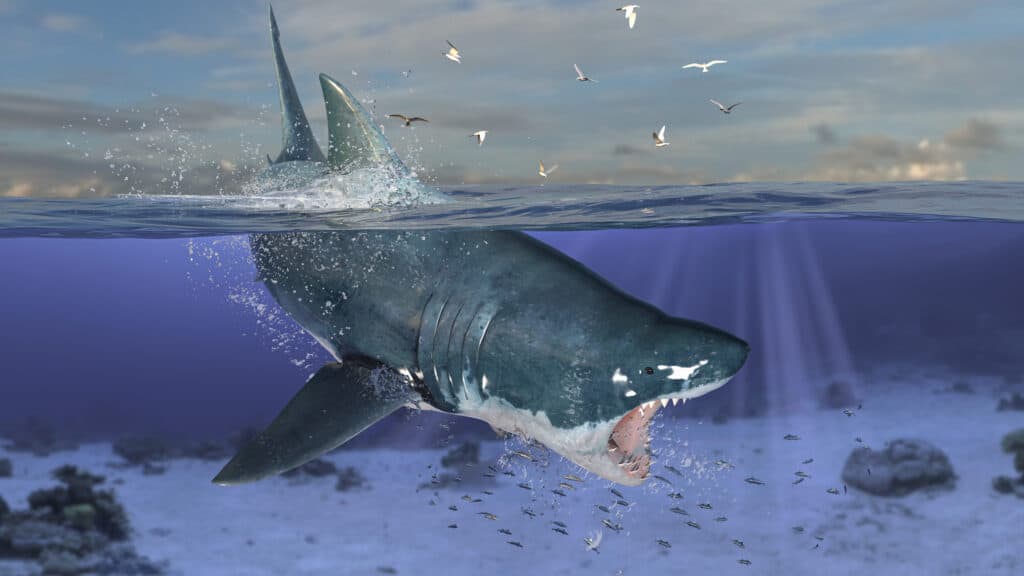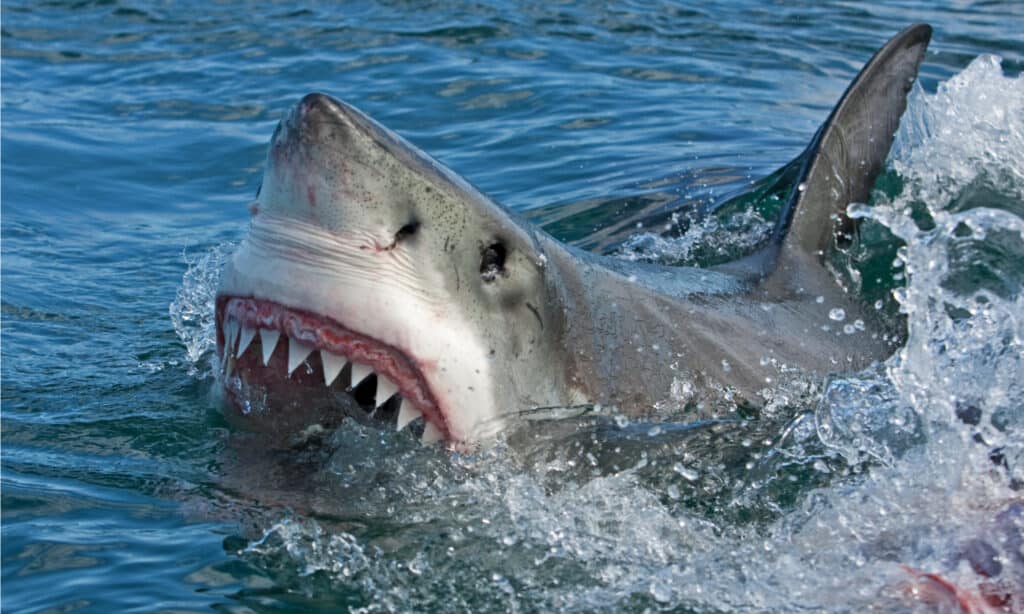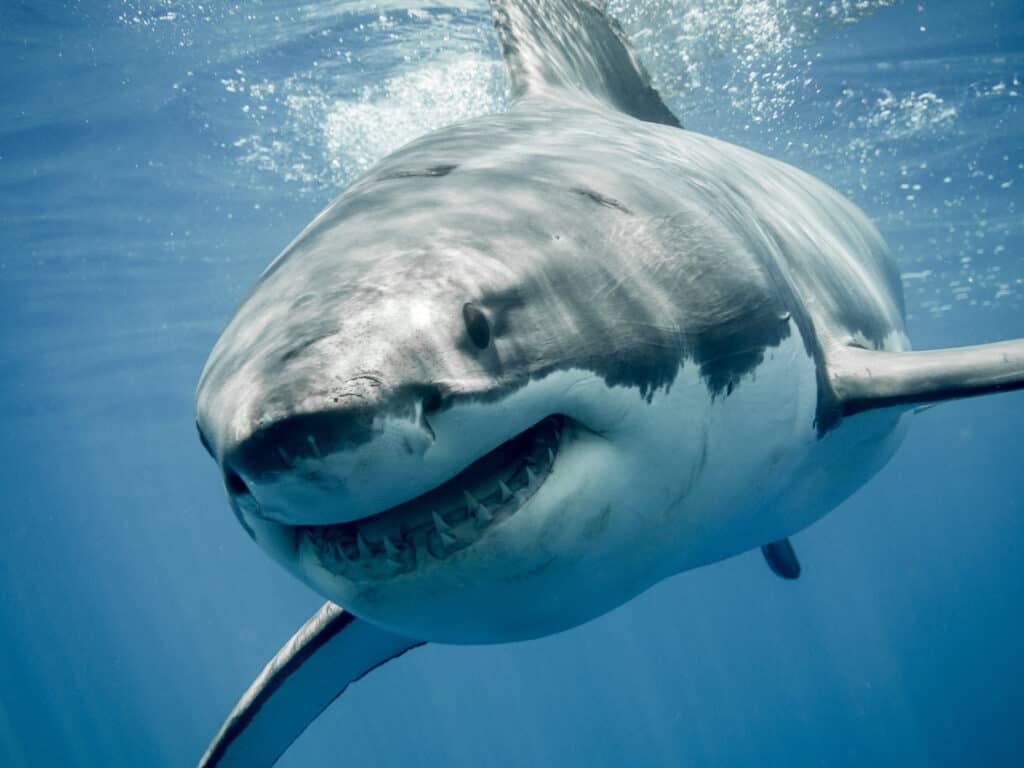Great white sharks are the biggest movie stars among the entire shark species. The popular movie ‘Jaws’ depicted the horrors of large underwater predators, and the clear casting choice was the great white shark. These dark gray sharks are fierce-looking and can grow between 13 to 16 feet (3.96-4.88 meters) which is larger than three humans, making them one of the biggest fish worldwide.
These large fish can be spotted in coastal waters, sometimes near shore, hunting for prey. Equipped with sharp teeth, tough skin, and sheer size reaching 5,000 pounds, these apex predators are feared with reason. Despite their frightening looks, it’s normal to wonder if great white sharks are dangerous and aggressive to humans or if the species is misunderstood. Let’s find out.
Are Great White Sharks Aggressive?

The great white shark is the most aggressive shark in the world.
©iStock.com/https://a-z-animals.com/blog/the-7-most-aggressive-sharks-in-the-world/
Great white sharks, or simply the great whites, are the most aggressive sharks worldwide. The temperaments of these sharks are matched by their fierce looks. These large fish are apex predators, with very few marine animals matching their strength, ferocity, and size. Great white sharks shy away from no creatures, including humans.
Mistaken identity is one of the foremost reasons a shark might be aggressive towards a human. From the bottom of the ocean, surfers might be mistaken for seals. Since great white sharks occasionally attack inanimate objects, it is also assumed that these aggressive swimmers might also attack to decide the potential of an unfamiliar object as food.
Are Great White Sharks Dangerous?

The great white shark is the most dangerous shark in the world.
©Martin Prochazkacz/Shutterstock.com
Great white sharks are arguably the most dangerous sharks in the ocean. Almost no creature of considerable size in the ocean is safe from these aggressive sharks, not even some whales, and great whites have no predators besides humans and killer whales.
Great white sharks are dangerous both underwater and above water, breaching the water surface occasionally to catch prey, despite their heavy size. Unsuspecting surfers can be mistaken for prey and attacked quickly from below. With about 300 serrated teeth, their bites can be extremely painful.
However, despite their problematic behavior of attacking humans, great white sharks do not fancy human flesh. Most attacks from these sharks have been lacerations and other injuries without tearing off the flesh. According to reports, juvenile sharks are more liable to mistake humans as prey than adult great whites because they have poorer sight.
How Many Shark Attacks Have Involved The Great White?

There have been about 350 unprovoked great white shark attacks in the last 200 years.
©Ramon Carretero/Shutterstock.com
Great white sharks are the highest ranking shark attack culprits in the world. According to the ISAF, there have been about 350 unprovoked great white shark attacks in the last two centuries, and about 57 were fatal. These predatory sharks are responsible for almost half of shark attacks annually, more than the tiger sharks and bull sharks which are close behind them.
Despite the dangers of shark attacks, only an average of 70 attacks occur yearly, and those are small numbers compared to the human population. Some swimmers have never even encountered a shark in all their years of swimming in coastal waters.
Great White Sharks Facts
Despite the common sightings of great whites in coastal waters, little is known about them. Here are 2 facts about great white sharks that you probably did not know:
1. Great white sharks belong to the Lamnidae family
Great white sharks belong to the Lamnidae family, often called mackerel sharks. The family name, Lamnidae, was derived from the Greek word ‘Lamna,’ which translates to fish of prey. These predatory sharks are large, fast-swimming, and usually spotted in deep waters worldwide. They prefer colder regions due to their ability to maintain a higher body temperature than the water around them.
The great white shark shares similar features with other members of its family, such as its pointed snout, large gill openings, and spindle-shaped body. Other members of the family are the porbeagle, mako sharks, and salmon sharks.
Furthermore, the great white shark belongs to the order Lamniformes. Members have single anal fins, two dorsal fins, five gill slits, and mouths that extend beyond their eyes, unlike hammerhead sharks.
2. Great whites can attain speeds of 30 mph
According to scientists, an 11.5 feet (3.51 meters) great white shark could attain a speed of up to 21 mph (33.80 kph). This puts these quick hunters as one of the fastest sharks worldwide. In short bursts, these large fish can reach up to 30 mph (48.28 kph). Their remarkable speeds are due to their strong tail fins and torpedo-shaped bodies.
Humans have been recorded to swim to a record of 5.12 mph (8.24 kph) over a short distance. This speed pales compared to many sharks and gets slower over longer distances. The great white shark can swim four times faster than humans and keep up its speed for longer.
What Do Great White Sharks Eat?
Great white sharks are carnivores that feed on various marine animals of different sizes. According to reports, great white sharks have five acute senses that make them superior hunters underwater. They can track prey from incredible distances by detecting blood and sensing the movement of prey against the currents around them using electroreceptors in their snouts.
These sharks are opportunistic hunters who often hunt during the day. They locate prey and ambush them quickly, swimming fast to attack their prey under and above the water. Then, the sharks retreat, allowing their victims to bleed out and weaken or die before they return to feed. Great whites eat a wide range of fish, including other sharks. Other marine animals that these sharks target are seals, seabirds, and dolphins.
One of the reasons that humans do not make great white sharks’ menus might be the low-fat content in humans. Great white sharks often go after animals or fish with more fat, meat, and nutrients. They are believed to consume up to 11 tons of food annually.
Where are Great White Sharks Found?
Great white sharks are cosmopolitan, i.e., they can be found worldwide. They are mostly found in temperate seas, tropical waters, and the open ocean. In the United States, they can be found on both the eastern and western coastlines.
Great whites can be found on the Western Atlantic from Newfoundland to Florida and the Gulf of Mexico. In the Central Pacific, they can be found off the Hawaiian Islands and from Alaska to the Gulf of California.
Is it Illegal to Hunt Great White Sharks?
Great white sharks are delicacies in parts of Asia, especially to make fin soup. Due to their relatively low population in the region, great white fins or meat are quite pricey. However, in other parts of the world, such as the United States and New Zealand, they are considered a vulnerable species, making it illegal to hunt them.
Up Next:
The 7 Most Aggressive Sharks in the World
Are Lemon Sharks Dangerous or Aggressive?
Are Tiger Sharks Dangerous or Aggressive?
The Largest Great White Sharks Ever Found off Florida Waters
The photo featured at the top of this post is © Alessandro De Maddalena/Shutterstock.com
Sources
- OCEAN, Available here: https://ocean.si.edu/ocean-life/sharks-rays/great-white-shark
- Florida Museum, Available here: https://www.floridamuseum.ufl.edu/shark-attacks/factors/species-implicated/
- METRO, Available here: https://metro.co.uk/2021/10/28/we-finally-know-why-great-white-sharks-attack-humans-15501937/
Thank you for reading! Have some feedback for us? Contact the AZ Animals editorial team.






